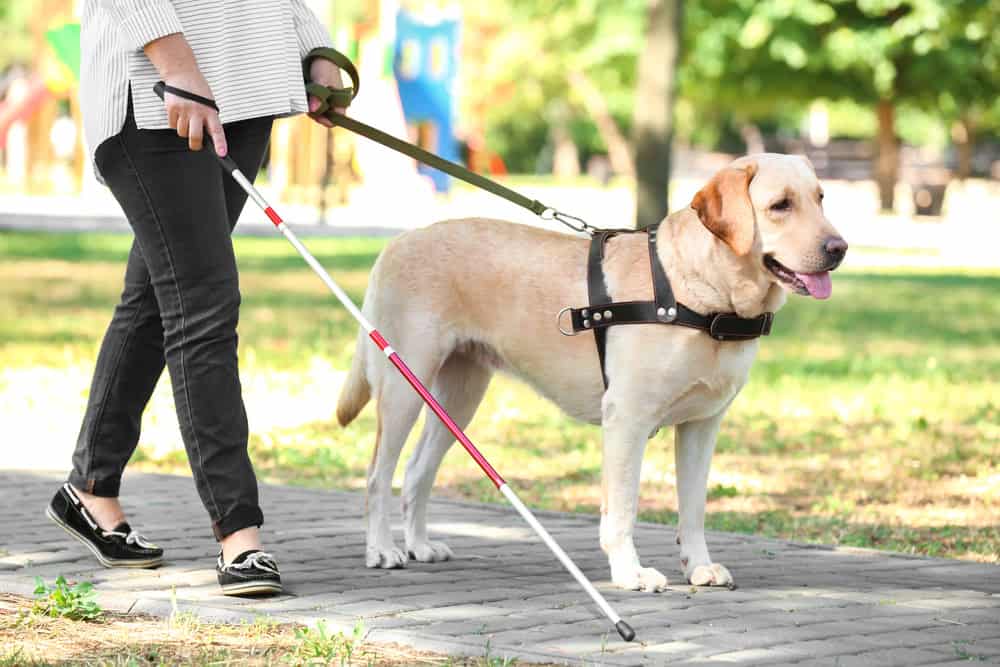Would you like to live with your ESA without paying extra fees?

What is an Emotional Support Animal?
An emotional support animal is a type of assistance animal that helps mitigate the symptoms of mental or emotional disabilities such as depression, anxiety, and post traumatic stress. Such assistance animals are typically prescribed by a licensed mental health professional as part of an individual’s treatment plan. The prescription takes the form of an official document called an emotional support animal letter, also known as an ESA Letter. This document confirms that an individual has a legitimate need for the support that their companion animal provides and entitles them to certain rights under federal law.
What is an ESA Letter For?
An ESA letter is an official document signed by a licensed mental health professional. An ESA letter can also be prescribed by other health professionals who have familiarity with an individual’s medical condition or a person’s disability, such as a general practitioner or a psychiatrist.
Essentially, an ESA letter takes the form of a prescription. It recommends the use of an emotional support animal as part of a person’s treatment plan when it comes to managing their mental health. This means that the mental health professional believes their client can benefit from the therapeutic relationship and emotional comfort that emotional support animals provide.
ESAs are commonly prescribed to those living with mental disabilities or emotional conditions such as anxiety, depression, PTSD (post traumatic stress disorder), and other types of mental disorders which can be found in the Diagnostic and Statistical Manual, a handbook published by the American Psychiatric Association and used by mental health professionals all over the world to establish reliable diagnoses.

When a mental health professional has determined that a person can benefit from the companionship of a support animal, they will issue that individual an ESA letter. A legitimate ESA letter will be printed on the licensed professional’s letterhead and include their licensing information in addition to being signed and dated by the prescribing professional. The ESA letter will clearly establish that the patient in question has a confirmed disability and that an emotional support animal provides them with needed support.
These days, the internet is rife with scams when it comes to fraudulent ESA websites and fake ESA letters. As a result, it’s absolutely essential for those in genuine need of an emotional support animal to understand what a legitimate ESA letter contains as to avoid getting scammed by services that don’t comply with federal and state regulations. Only a legitimate ESA letter is recognized under federal law, and only a legitimate ESA letter entitles an individual to certain rights when it comes to reasonable accommodation from housing providers while also permitting an individual to travel with their animal on ESA-friendly airlines.
It’s important to note that an ESA letter does not designate a companion animal as a service animal. Emotional support animals and service animals both provide assistance to their handlers, but they hold different designations under federal regulations and are entitled to different kinds of rights.
Ready to Get Started?
See if you qualify for an Emotional Support Animal right away! Take the free, 5-minute pre-screening test right now and receive instant results. If you qualify, you’ll have the option to move forward with an ESA Letter Consultation with a licensed mental health professional!
Emotional Support Animals vs. Service Animals
There are all kinds of assistance animals in the world today that provide a great service to those who rely on their support.
Emotional Support Animals, also called ESAs or comfort animals, are companion animals that offer comfort and support to those living with emotional disabilities such as anxiety, depression, social phobias, and other mental health disabilities.
The most common type of emotional support animal is an emotional support dog, and there are many popular dog breeds commonly used for their natural talent for providing emotional comfort, but there are no federal regulations stating that only dogs are permitted to provide this service. Emotional support animals can also include cats, rabbits, and other types of pets. The animal simply needs to be able to provide emotional support to an individual in order to be recognized as an ESA.
ESAs aren’t individually trained to perform tasks the way service animals are. As a result, their rights are limited when it comes to certain types of public access and, in some cases, air travel.
Service Animals, on the other hand, receive extensive training (and often highly specialized training) in order to provide assistance to their handlers. The most common types of service animals are service dogs.
Service dogs are commonly trained to perform a specific task or a set of tasks. A seeing-eye dog, for instance, helps a visually impaired individual or fully blind person navigate life in a safe manner that gives them their independence back. Other types of service dogs include diabetic alert dogs, hearing dogs, and mobility assistance dogs, among many others.
Because service dogs provide assistance for major life activities such as getting around throughout the day, opening doors, turning on lights, setting off alarms, and in some cases alerting a person to potentially-deadly blood sugar levels, they’re entitled to the broadest possible range of privileges and rights under federal law.

Psychiatric Service Dogs are another type of service animal. A psychiatric service dog is a type of service dog that has been individually trained to perform tasks that help with the emotional issues of a person’s disability.
A specific task may entail a psychiatric service dog providing deep pressure therapy to help their handler through a panic attack. Psychiatric service dogs may also help with assistive actions such as waking up their handler from a night terror or guiding their handler to a safe space during an anxiety episode. The U.S. Department of Justice also offers the example of a psychiatric service dog reminding their handler to take their medication, which is considered a ‘Medical Reminder’ task.
Just like any other service animal, psychiatric service dogs receive extensive training to perform tasks that assist their handler and are commonly prescribed to those living with post traumatic stress, anxiety, and other types of emotional disabilities. Because being separated from their psychiatric service dog substantially limits an individual’s ability to thrive as much as possible, psychiatric service dogs are also entitled to the same privileges and rights as any other type of service dog. Some of the most common dog breeds used for psychiatric service include Golden Retrievers, Labrador Retrievers, and German Shepherds.
Therapy Animals aren’t entitled to special rights the way emotional support animals or service animals are, but they still provide an incredible service to those on the receiving end of their attention. Therapy animals are commonly found in hospitals and nursing homes and their task is simple: to comfort people. Therapy animals can also be found on-site after major tragedies or natural disasters to offer emotional support to those in need.

Service Animal and Emotional Support Animal Laws
It’s helpful to understand the difference between service animals and emotional support animals when it comes to important issues such as the basic requirements of their training regimen, the functions they must perform to uphold their designation as an assistance animal, and how an individual can qualify for one or the other.
Another important distinction between service animals and emotional support animals are the rights and privileges each is entitled to under federal regulations.
What is the Americans with Disabilities Act?
The Americans with Disabilities Act became law in 1990 and prohibits discrimination against people with disabilities. This protection extends to all areas of public life, including employment, education, transportation, and public accommodations. For instance, The United States Department of Transportation ensures that transit agencies comply with the ADA to make public transit vehicles and facilities accessible to those with disabilities, and the U.S Equal Employment Opportunity Commission (EEOC) also enforces the ADA by prohibiting employers from discriminating against qualified individuals on the basis of a disability.
When it comes to service animals, the Americans with Disabilities Act is the most important piece of legislation to be familiar with. This piece of legislation states that “Under the ADA, state and local governments, businesses, and nonprofit organizations that serve the public generally must allow service animals to accompany people with disabilities in all areas of the facility where the public is allowed to go.”
This law extends to public access rights (meaning service animals can accompany their owner in public places such as restaurants, malls, local government agencies, and stores where animals are not normally allowed) and educational facility access rights (meaning service animals are permitted to accompany their owners into schools, colleges, and universities).

In addition to the Americans with Disabilities Act, there are two federal statutes that those with service animals and emotional support animals should be familiar with.
What is the Fair Housing Act?
The Fair Housing Act applies to both emotional support animals and service animals. It was signed into law in 1968 and protects people from discrimination during housing-related activities such as renting when it comes to race, religion, or disability. The Fair Housing Act ensures that an individual with a mental illness or mental disability does not experience housing discrimination because of their need for an emotional support animal or service animal. Housing providers must instead provide reasonable accommodations for these individuals and are not allowed to charge the individual any type of fee, such as pet deposits.
Those with emotional support animals will need to present their landlord with an ESA housing letter to demonstrate their need for the animal’s support. This is why it’s essential to seek out a legitimate ESA letter, as only a legitimate ESA letter is recognized under law. Legitimate ESA letters must be signed and dated by a licensed mental health professional, must include the professional’s licensing information, and must be printed on the practitioner’s professional letterhead.
Just like with the ADA, there are local government agencies and other federal departments that work to ensure fair and equal housing opportunity for all, such as The U.S. Department of Housing and Urban Development, which provides comprehensive resources on tenant rights, laws, and protections.

What is the Air Carrier Access Act?
The Air Carrier Access Act went into effect in 1986 and prohibits discrimination in air travel on the basis of a person’s disability. This law requires air carriers to accommodate the needs of passengers with disabilities, including the accommodation of service animals. Because of the Air Carrier Access Act (ACAA), service animals are permitted to ride in the airline cabin with their handler (provided the animal is not too large or too heavy) and a person with disabilities cannot be charged a pet fee when traveling with their service animal. This law applies to all flights of U.S. airlines as well as flights to or from the United States by foreign airlines.
Airlines may, however, request specific documentation and/or 48-hour advanced notice if a service dog is boarding a flight, such as an official document from a licensed mental health professional confirming an individual’s mental or emotional disability and their need for their assistance animal.
For a psychiatric service dog, this document will take the form of a Psychiatric Service Dog Letter, also called a Psychiatric Service Dog Travel Letter. For emotional support animals, this document is commonly referred to as an ESA Letter, or more specifically, an ESA Travel Letter. The allowance of emotional support animals onboard flights varies from airline to airline, however, so travelers should always contact an airline in advance to confirm any policies or restrictions when it comes to emotional support dogs and other types of assistance animals. Travelers may also opt to book their flight with an ESA-friendly airline to better suit their travel needs.
If at any time, an airline staff member is violating a disabled person’s rights under the ACAA, that individual has the right to speak with a Complaints Resolution Official (CRO). The U.S. Department of Transportation advises that “A CRO is the airline’s expert on disability accommodation issues. Airlines are required to make one available…at no cost, in person at the airport or by telephone during the times they are operating.”
Ready to Get Started?
See if you qualify for an Emotional Support Animal right away! Take the free, 5-minute pre-screening test right now and receive instant results. If you qualify, you’ll have the option to move forward with an ESA Letter Consultation with a licensed mental health professional!
Are Emotional Support Animals Allowed on Flights?
As of January 11, 2021, the U.S. Department of Transportation allows each individual airline to determine its own policies and regulations when it comes to emotional support animals.
While airlines such as Delta, United, and Air Canada no longer recognize emotional support animals as a type of assistance animal, these air carriers may still permit individuals to travel with their comfort animal as long as the individual pays a pet fee, the way pet owners typically do when traveling with a companion animal.
There may, however, be restrictions in place in terms of an animal’s weight, size, or breed, so ESA owners should always contact their airline of choice ahead of time for more information about the air carrier’s policies. Those with concerns can also opt to travel with one of several ESA-friendly airlines that still permit emotional support animals onboard flights. These airlines will require proper documentation (in the form of an ESA letter) in order to confirm that the animal’s presence is required to help with emotional conditions or a mental disability.

How to Qualify for an ESA Letter / Emotional Support Animal
As previously mentioned, comfort animals like emotional support dogs are commonly prescribed to those living with mental disabilities or emotional conditions such as anxiety, depression, PTSD (post traumatic stress disorder), and other types of mental disorders. A person’s disability must be one that’s found in the Diagnostic and Statistical Manual, also known as the DSM. Mental health professionals all over the world commonly refer to this handbook to establish reliable diagnoses.
To qualify for a comfort animal, therefore, a licensed mental health professional must first determine that an individual has a mental disability or mental illness as classified by the DSM. Apart from mental health professionals such as psychologists and licensed counselors, this determination can also be made by an individual’s general practitioner.
For those who may not already have access to a mental health professional or physician, telehealth can help make the process of getting an emotional support dog easy. Telehealth platforms such as CertaPet improve access to mental health care, with a focus on providing services to individuals who are seeking animal assisted interventions as part of their treatment plan.

Typically, the process of getting an emotional support animal letter from one of these telehealth platforms will begin with an online questionnaire. The online questionnaire serves as a pre-screening to determine if an individual qualifies for an emotional support dog or cat (although other domestic animals like rabbits are also a common option).
The online questionnaire takes only minutes to complete, and if the pre-screening determines an individual qualifies for an ESA, they are then connected to a licensed mental health professional for a consultation. The mental health professional will speak with the individual about their needs, and if the professional believes an ESA will be a beneficial part of the patient’s treatment plan, they will issue an emotional support animal ESA letter. An individual will typically receive immediate access to a PDF version of their emotional support animal letter, which they can print from a home computer. Most telehealth platforms also offer the option of mailing an ESA letter.
A legitimate ESA letter will always be printed on the licensed professional’s letterhead and include their licensing information in addition to being signed and dated by the prescribing professional. The ESA letter will clearly establish that the patient in question has a confirmed disability and that an emotional support animal provides them with needed support.
The ESA letter entitles its holder to reasonable accommodation when it comes to housing (meaning an individual cannot be charged a pet fee or pet deposit for having an ESA, nor can they be denied housing in a no-pets property). This reasonable accommodation is made possible because of the Fair Housing Act. An ESA letter also provides the proper documentation required when traveling with an airline that permits emotional support dogs and other types of ESAs onboard flights.
What Types of Pets Can Be an Emotional Support Animal?
Emotional support dogs are the most common type of comfort animal. This is because emotional support dogs tend to be easy to train and because dogs in general are typically allowed in a greater variety of places such as dog-friendly public parks and other dog-friendly locations. However, cats and rabbits can also be ESAs, as can miniature horses.
Exotic animals such as sugar gliders, snakes, and certain types of amphibians, birds, and insects can also be designated as an ESA. However, an exotic animal may not be entitled to the same reasonable accommodation as domestic animals. For instance, airlines that allow ESAs typically only permit dogs or cats onboard, as some animals (especially untrained ones) can pose a risk to public health. For these reasons, mental health professionals will typically recommend that an individual select a domestic animal as their ESA.

Is a Registry Site or Emotional Support Animal Vest Required?
An individual does not need to register with any ‘national databases’ or ‘registry sites’ to prove their animal is an ESA. While many fraudulent sites claim that an ESA will need a registration number to validate its status, this isn’t in any way the case and is simply the rhetoric of typical ESA scams. All that’s required to confirm that an animal is an ESA is a legitimate ESA letter signed by a professional licensed in mental health.
However, many ESA owners still choose to outfit their animal in special vests or harnesses that clearly distinguish the animal from an ordinary pet. An ESA ID card is also a common item these individuals make it a point to have on hand. These items help communicate that a comfort animal is ‘on duty’ and therefore shouldn’t be disturbed. These items also help communicate to personnel such as a landlord or an airline staff member that the animal provides needed assistance that supports certain disabilities.
Ready to Get Started?
See if you qualify for an Emotional Support Animal right away! Take the free, 5-minute pre-screening test right now and receive instant results. If you qualify, you’ll have the option to move forward with an ESA Letter Consultation with a licensed mental health professional!
How to Get an Emotional Support Animal
A pet that an individual already owns can serve as their ESA if the animal is one that already provides emotional comfort and support. For those who don’t already have pets, there are no restrictions as to an ESA’s species, breed, size, or weight, which makes it easier for individuals to select the perfect comfort animal for their unique needs.
Licensed mental health professionals recommend selecting a domestic animal as a person’s ESA, as this makes it easier to enjoy the animal’s constant companionship when it comes to housing and travel situations.
Individuals can easily find a comfort animal through local animal shelters or rescue groups. Most of these organizations will allow a person to interact with their dog or cat of choice pre-adoption to ensure there’s a connection between the two, allowing individuals to select an animal that will provide emotional support and the much-needed comfort they’re seeking.

Frequently Asked Questions
Can you have more than one ESA?
An individual can have more than one ESA if their health professional agrees that more than one animal can help to promote their well-being and that each animal will play a role in the person’s treatment plan. An individual consultation is needed for each animal.
What makes a legitimate ESA letter?
A legitimate ESA letter should be printed on the licensed professional’s letterhead and include their licensing information in addition to being signed and dated by the prescribing professional. The ESA letter will clearly establish that the patient in question has a confirmed disability and that an ESA provides them with needed support.
What if my landlord doesn’t allow pets?
The Fair Housing Act ensures that an individual with a mental illness or mental disability does not experience housing discrimination because of their need for an ESA. Housing providers must allow ESAs to live with their owners, regardless of any no-pets policy in place. They are also prohibited from charging pet-related deposits or fees for the ESA.
Do emotional support animals have a size limit?
There are no restrictions when it comes to an ESA’s species, breed, size, or weight. However, some ESA-friendly airlines may have certain restrictions in place when it comes to a dog’s breed. Other airlines may not allow certain species (such as exotic animals) onboard flights.
Are ESAs allowed in all public places?
ESAs are not entitled to the same public access rights as a service dog and are therefore not always allowed in all public places. A legitimate ESA letter entitles ESA owners to reasonable accommodation when it comes to housing and can also allow the individual to travel with their animal on ESA-friendly airlines. However, ESAs may not be allowed in certain establishments such as restaurants or hotels unless such businesses are already pet-friendly.
Can I bring my emotional support animal on flights?
As of January 11, 2021, the U.S. Department of Transportation permits each individual airline to determine its policies and regulations when it comes to the allowance of ESAs onboard flights. Some airlines still permit animals to fly with their owners but may now require the payment of a pet travel fee. Those traveling with an ESA should contact their air carrier of choice ahead of time to confirm its policies and restrictions when it comes to ESAs.
Ready to Get Started?
See if you qualify for an Emotional Support Animal right away! Take the free, 5-minute pre-screening test right now and receive instant results. If you qualify, you’ll have the option to move forward with an ESA Letter Consultation with a licensed mental health professional!
